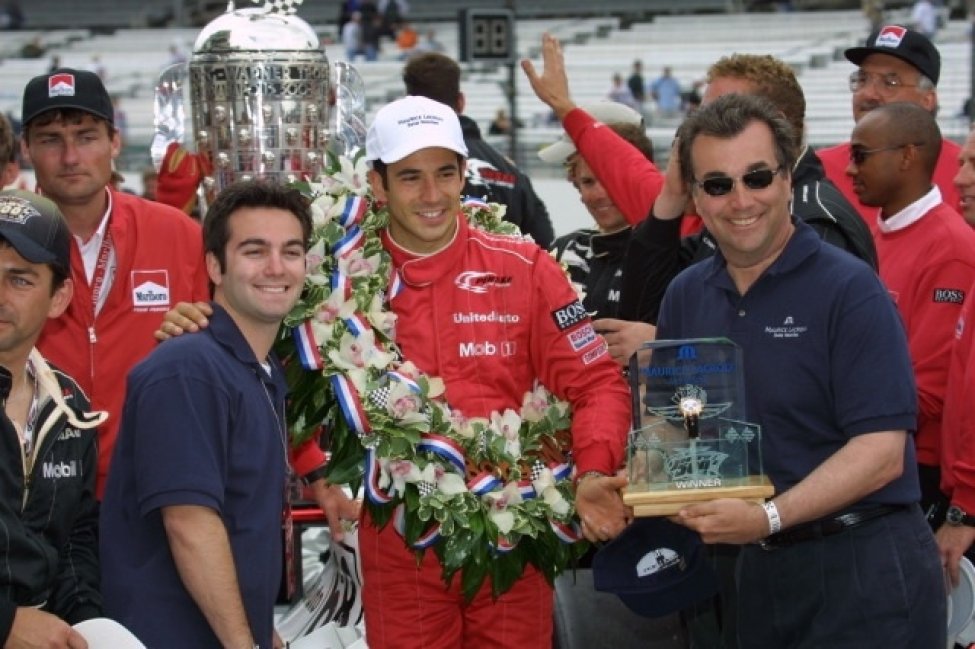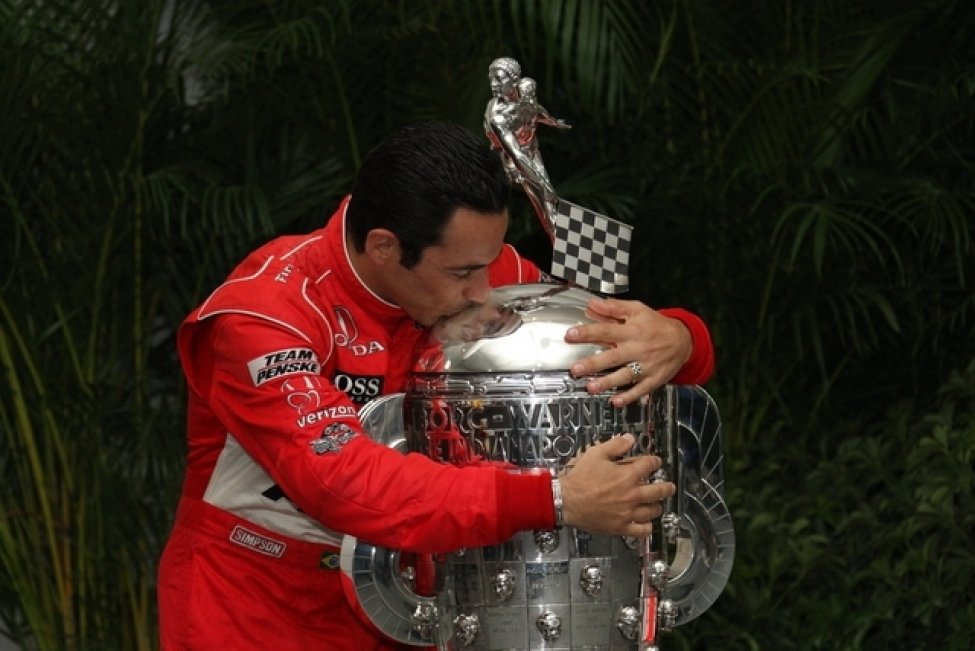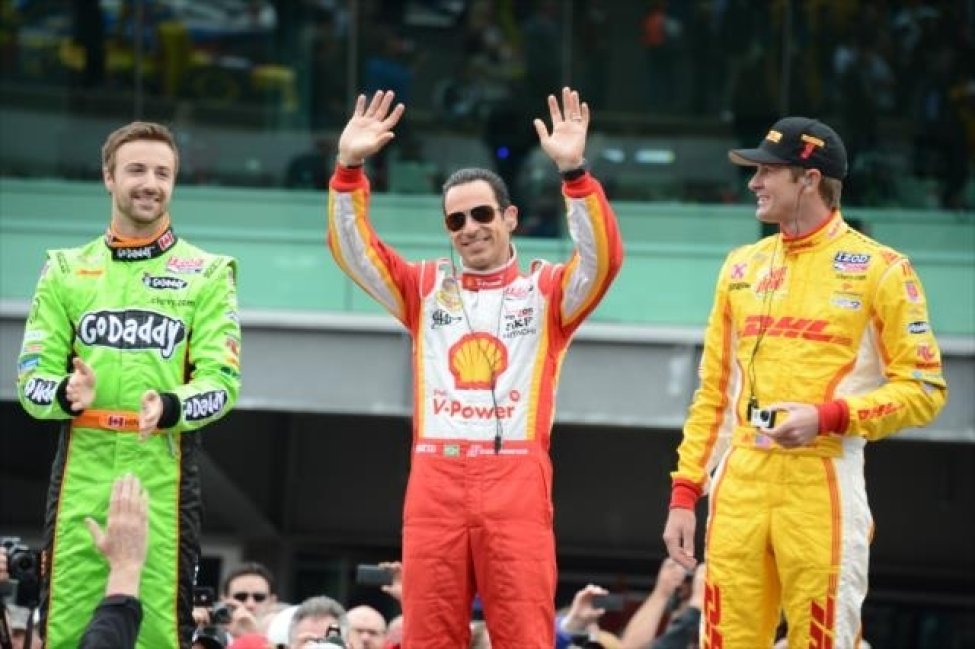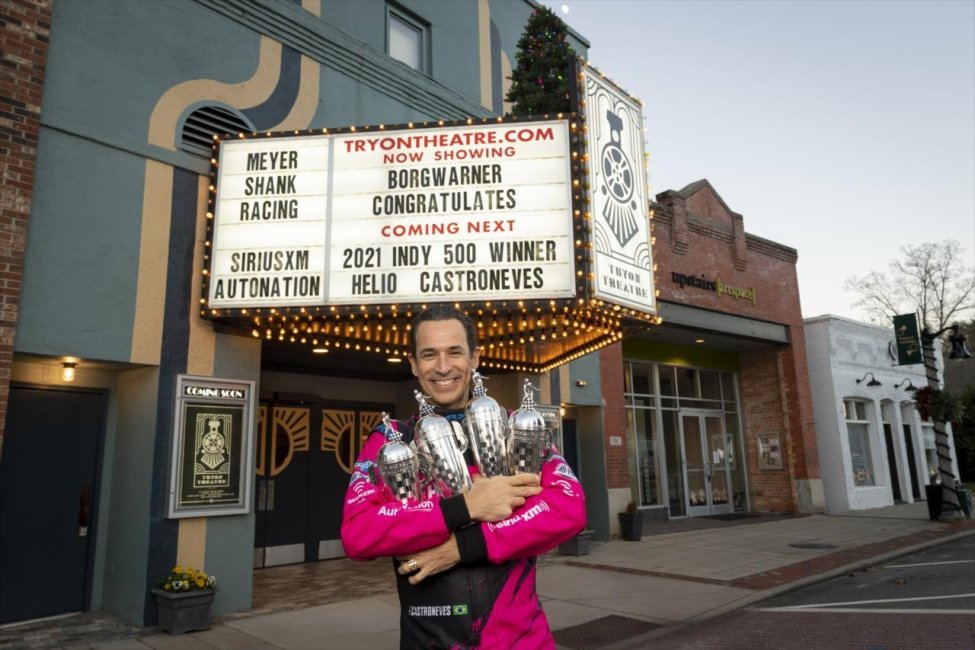Helio Castroneves
Hélio Castroneves is a Brazilian IndyCar Series driver. He has won the famous Indianapolis 500 four times and was runner-up in the IndyCar Series drivers' championship in 2002, 2008, 2013 and 2014. Read all about the Brazilian driver on this page.
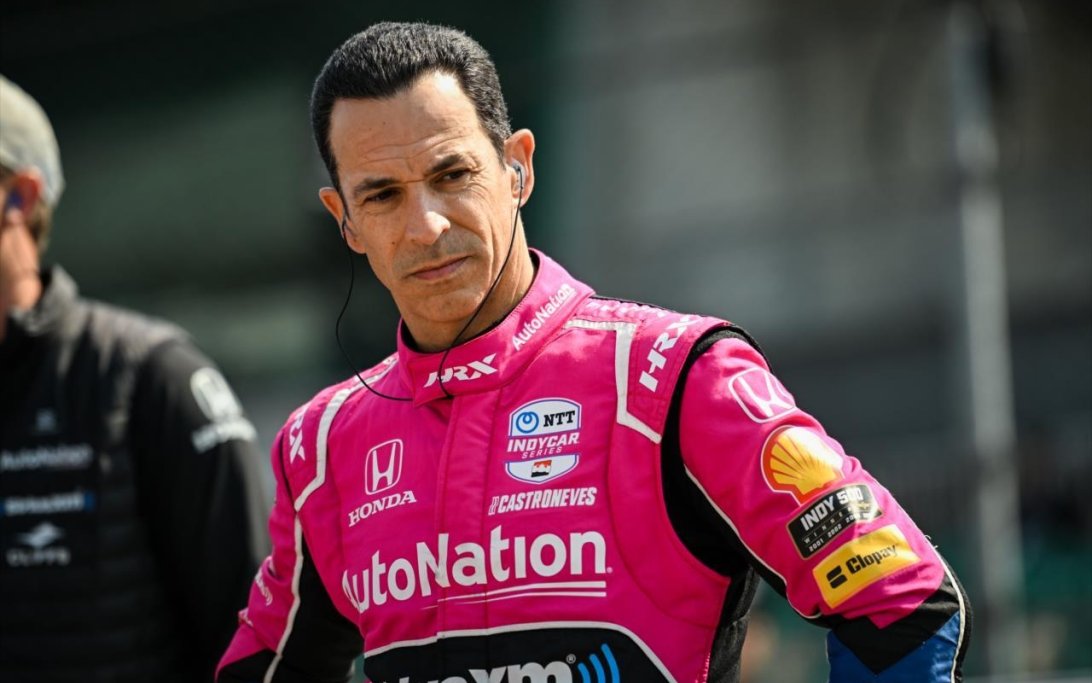
Early and Personal Life of Helio Castroneves
Castroneves, born on May 10, 1975, in São Paulo, Brazil, comes from a family deeply connected to the automotive industry. His father, Hélio Castro Neves, was an automobile dealer, and his mother, Sandra Alves de Castro Neves, worked as a school teacher. Alongside his older sister, Katiucia, who now manages his business affairs, Castroneves grew up in São Paulo, where he received his education. In 1977, the family relocated to Ribeirão Preto, a town known for its thriving ethanol processing industry, allowing his father to expand his business opportunities. To avoid media confusion and misidentification, Castroneves decided to change his surname from Castro Neves to Castroneves in 2000. Castroneves also has a daughter with his long-time partner, Adriana Henao.
Helio Castroneves Early Career
During his formative years from early 1981 to 1986, Castroneves had a unique way of experiencing his father's stock car team races. He would be discreetly hidden in the trunk of a car, wearing racing overalls and a helmet, granting him access to the racing circuit. This allowed him to witness the excitement firsthand. At the age of seven, he received a child-sized motorized car, which he frequently drove around the streets of his gated community. His growing interest led him to ask his father about go-karting. On his 11th birthday, Castroneves received his first go-kart as a gift from race car driver Alfredo Guaraná Menezes. This marked the beginning of his karting journey at a track in São Paulo. Although his mother was apprehensive about the dangers of racing, she enrolled him in various other sports such as football, judo, swimming, tennis, and volleyball. However, Castroneves soon expressed his desire to pursue racing and was inspired by the accomplishments of three-time Formula One world champion Ayrton Senna.
In early 1987, Castroneves' father enrolled him in the Karting State Championships in São Paulo. Showing great progress, he earned his first trophy later that year. To support his passion, his father sold their property in Rio de Janeiro and established a karting team specifically for Castroneves. At the age of 13, he left full-time schooling to focus on karting and learn from his father and the team members, despite his mother's concerns about not having a backup career. Castroneves' dedication paid off when he won the 1989 Brazilian National Go-Kart Championship at the age of 14. During this time, he and his family avidly followed CART and Formula One races on television. He also took part in weightlifting and tennis to improve his physical fitness from October 1989 to March 1990.
In 1990, Castroneves decided to forgo the Brazilian National Go-Kart Championship and traveled to Italy to participate in the Karting World Cup. This allowed him to gain experience with more powerful and high-grip European go-karts. However, due to administrative complications, his registration was initially impeded by a mix-up with the Brazilian Autosport Confederation. Eventually, he managed to compete after another karter suffered an arm injury. Castroneves finished 16th in the race. The following year, he participated in the Karting World Cup in France without any registration issues and achieved a 25th place finish. Additionally, he continued to win races in Brazil, further solidifying his skills and passion for racing.
Car racing
At the age of 16, Castroneves entered the world of car racing, joining Formula Chevrolet Brazil, a series designed for go-kart graduates. His parents hired a trainer to help him improve his car control through weightlifting, and he frequented a local recreational center. Although negotiations with the Arisco team fell through due to a sponsorship requirement of $200,000, Castroneves' father invested $250,000 in his own team. Racing with a Copral-Berta-Chevrolet car, Castroneves had an impressive season, finishing as the runner-up in the championship with one victory and 92 points over eight rounds.
In 1993, Castroneves moved up to the higher-tier Formula 3 (F3) Sudamericana series, driving a Ralt RT34-Mugen Honda car for Copral and later the funded Amir Nasr Racing Team. Despite his five-year-old car lacking radio communication due to a missing aerial, Castroneves showcased his skills and ended the season as the championship runner-up to Argentinean driver Fernando Croceri. He achieved four victories, eight podium finishes, and accumulated 57 points.
Castroneves competes in the Brazilian F3 Championship
The following year, Castroneves progressed to the Brazilian Formula Three Championship with the Amir Nasr Racing Team, impressively securing second place overall. He achieved three victories, four pole positions, and accumulated 52 points in eight races. In 1995, he joined Paul Stewart Racing in the British Formula 3 Championship, driving a Dallara F395-Mugen Honda car. With sponsorship from a Brazilian bank, Castroneves had a strong season, finishing third in the drivers' championship with 169 points. He achieved six podium finishes, a win at Donington Park, and also competed in the Masters of Formula 3 at Circuit Zandvoort, where he finished third. However, he unfortunately crashed out of the Macau Grand Prix.
In November 1995, Castroneves was offered the opportunity to participate in a four-day Indy Lights test session against nine other drivers. Despite not completing the test due to exhaustion, he secured a seat with Tasman Motorsports' third car. Partial funding came from the team, while the remaining support came from a corporate sponsor. This opportunity arose after another year in Formula Three became financially challenging. Competing in the 1996 season with the No. 8 Lola T93/20-Buick car, Castroneves achieved a victory at Circuit Trois-Rivières and recorded seven top-ten finishes, securing seventh place overall with 84 points. However, a series of accidents and his limited English proficiency posed challenges, leading him to seek assistance from a sports psychologist.
For the 1997 season, Castroneves continued with Tasman Motorsport. However, he faced the news that his sponsor was leaving, prompting his sister Katicia to seek support from various Brazilian companies. In an agreement with team owner Steve Horne, Castroneves raced with the condition that if he won five races, Horne would retain all prize money until Castroneves could reimburse him, effectively driving for free. Piloting the No. 29 Lola T97/20-Buick car, Castroneves finished as the championship runner-up, trailing his teammate Tony Kanaan. He secured three victories, six top-ten finishes, four pole positions, and earned a total of 152 points. On June 11, 1997, Castroneves enlisted the support of two-time Indianapolis 500 winner Emerson Fittipaldi, who became his manager and aided in finding sponsorships.
Hélio Castroneves IndyCar Series
In January 1998, Castroneves received an invitation from Tony Bettenhausen Jr., the owner of Bettenhausen Racing, to test for his Champ Car team at Sebring International Raceway. Impressed by Castroneves' performance, the team signed him to drive their No. 16 Reynard 98I-Mercedes-Benz car for the 1998 season. Tom Brown, a former Penske Racing employee, was assigned as Castroneves' race engineer. Despite sustaining a minor head injury during practice for the Grand Prix of Miami at Homestead-Miami Speedway, Castroneves was cleared by medical officials to compete.
During the season, Castroneves achieved his first top-ten finish in CART, securing ninth place at the Grand Prix of Long Beach. He followed it up with a season-high second-place finish at the Miller 200 held at Milwaukee Mile. By the end of the season, Castroneves stood 17th in the drivers' championship with 36 points. He also emerged as the runner-up in the Rookie of the Year standings, finishing behind his compatriot Tony Kanaan.
In mid-1998, Castroneves garnered interest from Chip Ganassi Racing and Team Rahal, who wanted him to replace Alex Zanardi, who was moving to Formula One. However, Emerson Fittipaldi, Castroneves' manager, blocked these deals as he believed Mercedes-Benz provided the best engine in CART. Unfortunately, Castroneves faced a setback when he was fired by Bettenhausen Racing in January 1999 and was replaced by Shigeaki Hattori, who brought sponsorship with him.
However, Castroneves quickly found a new opportunity with Hogan Racing, owned by Carl Hogan. On January 26, Castroneves agreed to drive for Hogan Racing in the 1999 season, taking over from JJ Lehto. The agreement was contingent upon Castroneves paying $3 million in sponsorship to the team. He raced with the No. 9 Lola B99/00-Mercedes-Benz car, which had an inconsistent engine performance. Despite the challenges, Castroneves managed to secure a ninth-place finish in the Firestone Firehawk 500K at Twin Ring Motegi and came in second in the Motorola 300 at Gateway International Raceway. In the Miller Lite 225 at Milwaukee, he achieved his first pole position in CART. Throughout the rest of the season, Castroneves recorded four more top-ten finishes, ultimately finishing 15th in the points standings with a total of 48 points.
Post-season, Hogan closed his CART team as Fittipaldi failed to secure the requested sponsorship money, resulting in Castroneves not receiving a salary. Castroneves and his sister independently negotiated with Walker Racing and Team Rahal as potential replacements for the departing Gil de Ferran, but these discussions did not lead to successful deals. The tragic accident that claimed the life of Greg Moore during the Marlboro 500 at California Speedway prompted Roger Penske, owner of Team Penske, along with team president Tim Cindric, attorneys, and sports agent Alan Miller, to sign Castroneves on a three-year contract under pressure from sponsor Marlboro, who demanded a replacement driver by a specific date. Following this, Castroneves ended his working relationship with Fittipaldi due to perceived mismanagement of his career.
Castroneves wins Greg Moore Legacy Award
In preparation for the 2000 season, Penske made significant changes, switching from building their own cars to using a Reynard 2KI chassis. They also transitioned from Mercedes-Benz engines to Honda and changed tire suppliers from Goodyear to Firestone, all in pursuit of improved performance. Castroneves initially found the driveability of the Honda engine different from that of Mercedes-Benz. Additionally, his relationship with teammate Gil de Ferran was initially strained due to their competitive nature. Castroneves secured his only points finish in the first six races with a second-place result at the Grand Prix of Long Beach. He achieved his first series victory by leading the final 24 laps of the Grand Prix of Detroit after Juan Pablo Montoya encountered mechanical issues. Castroneves further secured victories in the Miller Lite 200 at Mid-Ohio Sports Car Course and the Grand Prix of Monterey at Laguna Seca, earning a total of three wins and five top-ten finishes. He finished seventh in the drivers' championship with 129 points and was honored as the inaugural recipient of the Greg Moore Legacy Award, recognizing his on-track talent and engaging personality within the CART community.
In 2001, Castroneves drove the No. 3 Reynard 01I-Honda. Journalist David Phillips considered him a strong contender for the championship. Castroneves adopted a flexible race-by-race strategy, benefiting from the support of his teammate de Ferran and his crew. He showcased his prowess by leading all 82 laps from pole position to secure his fourth career win at the Grand Prix of Long Beach. Castroneves started from pole position at the Firestone Firehawk 500 in Motegi, leading the most laps before finishing second. He claimed his second victory of the season by leading every lap of the Grand Prix of Detroit. Another win came at the Miller Lite 200, propelling him to just one point behind championship leader Kenny Bräck. Although he temporarily lost the points lead with an 18th-place finish at Indy Vancouver, Castroneves rebounded with three top-six finishes in the final six races, ultimately securing fourth place in the drivers' standings with 141 points.
Castroneves' move to IndyCar
Castroneves made his debut in the Indy Racing League (IRL) in 2001, driving for Penske with the No. 68 Dallara IR-01-Oldsmobile car. His first race was the Pennzoil Copper World Indy 200 at Phoenix, which served as an introduction to the series before the iconic Indianapolis 500. Castroneves started in the 17th position but retired due to engine failure with three-quarters of the race completed. In his first Indianapolis 500, he qualified 11th and impressively led the final 52 laps to win the race on his maiden attempt.
In 2002, Castroneves made the transition to the IRL from CART as Marlboro wanted Penske to focus on the American market. Penske switched engine manufacturers from Oldsmobile to Chevrolet for their Dallara IR-02 car. At the second race of the season in Phoenix, Castroneves secured victory from pole position after overtaking his teammate de Ferran on the 183rd lap. The highlight of Castroneves' season came at the Indianapolis 500, where he controversially won the race. With only one-and-a-half laps remaining, CART driver Paul Tracy overtook Castroneves for the lead right as the yellow caution flag was raised due to an accident between Buddy Lazier and Laurent Redon. Despite an appeal from Tracy's team, IRL officials upheld Castroneves' second consecutive Indianapolis 500 victory. Castroneves finished no lower than ninth in the next nine races and battled his teammate de Ferran and Sam Hornish Jr. from Panther Racing for the championship. Ultimately, he ended the season as the runner-up with 511 points.
Before the 2003 season, Castroneves had the opportunity to test for the Toyota Formula One team at Circuit Paul Ricard in France. Although he impressed Toyota, he was informed that CART champion Cristiano da Matta had already signed as a race driver for 2003. Castroneves chose to stay with Penske, citing fair and loyal treatment from the team. In the early part of the season, he achieved two top-three finishes at Homestead-Miami, Phoenix, and the Indianapolis 500. Castroneves secured two consecutive second places at Richmond International Raceway and Kansas Speedway and won at Gateway International Raceway and Nazareth Speedway, which helped him take the points lead. However, a gearbox failure at Chicagoland Speedway resulted in a 20th-place finish, and a minor collision with Tony Kanaan in the season-ending race at Texas took him out of championship contention. He finished third in the points standings with 484 points.
In 2004, Castroneves was joined by Hornish at Penske after de Ferran's retirement from IndyCar. Initially, the two drivers had limited communication due to their contrasting personalities. He led most of the season-opening Toyota Indy 300 but was overtaken by Hornish on the final lap, settling for second place. In his fourth Indianapolis 500, Castroneves qualified eighth and finished ninth in the rain-shortened race due to a lack of horsepower against the Honda-powered cars. Two races later, he achieved his first pole position of the season at the SunTrust Indy Challenge in Richmond, ultimately finishing third. Throughout the season, he secured eight more top-ten finishes, four pole positions, and clinched his only win of 2004 by leading the final 21 laps at Texas in the season finale. Castroneves finished fourth in the drivers' championship with 440 points.
Penske's performance in 2004 positioned Castroneves as a potential outsider for the 2005 championship. He kicked off the season with a fifth-place finish in the Toyota Indy 300 and followed it up with a second-place finish at the XM Satellite Radio 200. In the Indianapolis 500, Castroneves started from the fifth position but slipped to ninth by the end of the race. However, he bounced back at the SunTrust Indy Challenge in Richmond, where he qualified second and dominated the race, leading the most laps to secure the victory. The relationship between Castroneves and his teammate Hornish became strained after a series of failed overtakes resulted in collisions between the two drivers. Castroneves secured pole positions at Pikes Peak International Raceway and Watkins Glen International and recorded six top-ten finishes in the final ten races of the season. He ended the season with 440 points, finishing sixth in the drivers' championship.
Castroneves in 2006
Before the 2006 season, Penske made a change in engine manufacturers, switching from the underpowered Toyota to the more potent Honda for its Dallara IR-05 car, as Toyota had withdrawn from IndyCar. Castroneves had a strong start to the season by winning his first series road course race at the Grand Prix of St. Petersburg, leading 40 laps from the fifth position. He continued his success with a back-to-back victory at Motegi, leading 184 laps from pole position and entering the Indianapolis 500 with a 42-point lead over Wheldon. However, Castroneves encountered handling difficulties during the race and crashed into the turn four barrier, resulting in a 25th-place finish. He bounced back with a win at the Bombardier LearJet 500 and a victory at Michigan International Speedway, entering the final race in Chicago with a one-point lead over Hornish. Castroneves finished fourth in the race and secured third place in the championship with 473 points.
In the 2007 season, Castroneves anticipated stronger competition compared to the previous year. His relationship with Hornish improved, and they began sharing information. He started the year with four top-nine finishes, including a win at the Grand Prix of St. Petersburg where he led 95 laps from pole position. Castroneves also claimed his third career Indianapolis 500 pole position but faced pre-race electrical and fueling issues that affected his performance, resulting in a third-place finish due to rain-shortened conditions. Despite a crash caused by a rear wing mounting failure at the ABC Supply Company A.J. Foyt 225, Castroneves secured six top-nine finishes and three more pole positions in the remaining races, ending the season in sixth place overall with 446 points.
The 2008 season started strongly for Castroneves as he achieved no lower than fourth place in the first four rounds, including consecutive second-place finishes at St. Petersburg and Motegi, propelling him to an early points lead. He qualified fourth for the Indianapolis 500 but dropped to fourth in the race due to front wing damage. Castroneves continued to secure podium finishes with second-place results in Texas and Richmond and consecutive pole positions at Nashville and Mid-Ohio. However, he ended a 29-race winless streak by winning the Peak Antifreeze Indy Grand Prix at Infineon Raceway, leading the most laps from pole position. Despite a second-place finish in Detroit that involved a penalty for blocking Justin Wilson, Castroneves entered the season-ending Peak Antifreeze Indy 300 with a 30-point deficit to championship leader Dixon. To claim the title, Castroneves needed to win the race and for Dixon to finish 11th or lower.
2009: Castroneves wins the Indy 500 for a third time
Castroneves secured a multi-year contract with Penske starting from the 2009 season. For the season-opening race in St. Petersburg, he was temporarily replaced by Will Power but returned to the team for the Grand Prix of Long Beach. The highlight of Castroneves' season came at the Indianapolis 500, where he claimed the fastest qualifying time and led for a total of 66 laps, ultimately securing his third victory in the prestigious race. He also achieved another victory at the Bombardier Learjet 550 in Texas. Throughout the season, Castroneves recorded six additional top-ten finishes, including a second place at the Edmonton Indy, and secured pole position at the Iowa Corn Indy 250 held at Iowa Speedway. His championship hopes ended at the Chicago race, and he concluded the season in fourth place overall with 433 points.
In the 2010 season, Castroneves had concerns about the performance of Penske's aging Dallara-Honda car and the potential advantage other teams could gain from it. However, he managed to secure a victory at the inaugural Indy Grand Prix of Alabama, extending his streak of winning at least one race for ten consecutive seasons. Despite qualifying on pole position at the Indianapolis 500, a pit stop issue dropped him to ninth place. He experienced ups and downs throughout the season, including being demoted to tenth place at the Honda Indy Edmonton due to blocking his teammate. Castroneves finished the season strong with consecutive victories at Kentucky Speedway and Motegi, ultimately ending up in fourth place in the drivers' standings with 531 points.
The beginning of the 2011 season was challenging for Castroneves, as he struggled to match his previous performance at Penske. He faced multiple collisions in the first four races, resulting in poor finishes. His best result during that period was a seventh-place finish at Birmingham, placing him 17th overall by the time of the Indianapolis 500. Although he qualified 16th for the race, tire issues left him one lap down in 17th place. Throughout the rest of the season, Castroneves managed to secure two second-place finishes and three top-nines. However, his overall performance suffered, and he finished 11th with 312 points, marking the first season since 1999 in which he did not win a race.
Prior to the 2012 season, Castroneves signed a contract extension with Penske. He started the season strongly by winning the season-opening Grand Prix of St. Petersburg after passing J.R. Hildebrand with 26 laps to go. He also secured pole position at the Indy Grand Prix of Alabama and finished third in the race. At the Indianapolis 500, Castroneves qualified sixth but struggled with car issues and finished tenth. Throughout the season, he consistently achieved sixth-place finishes at Milwaukee, Iowa, and Toronto, and won the Edmonton Indy. Castroneves ended the season with three more top-ten finishes, securing fourth place overall with 431 points.
Castroneves renewed his contract with Penske for the 2013 season. The team made modifications to his car during the off-season. He started the season strongly with podium finishes at the Grand Prix of St. Petersburg and the Honda Indy Grand Prix of Alabama, taking the points lead. However, he dropped to third place in the standings after finishing 13th in the São Paulo Indy 300. Despite encountering rev limiter issues at the Indianapolis 500, Castroneves finished in sixth place. He claimed victory at the Firestone 550 in Texas, regaining the points lead. Throughout the following races, Castroneves achieved two more second-place finishes and consistently finished no lower than ninth. Although he had a chance to win the championship, gearbox problems in the Grand Prix of Houston dropped him 25 points behind Dixon. In the season-ending MAVTV 500 IndyCar World Championships, a sixth-place finish for Castroneves secured him second place overall with 550 points.
Castroneves continued his partnership with Penske for the 2014 season. He secured a third-place finish at the season-opening Grand Prix of St. Petersburg and repeated the same result at the Grand Prix of Indianapolis three races later. Castroneves qualified fourth for the Indianapolis 500 and narrowly missed victory, finishing second in the second-closest finish in the event's history. He claimed pole position and won the second race of the Detroit Belle Isle Grand Prix. Despite facing a few challenging races, Castroneves finished second at the Pocono IndyCar 500 to tie his teammate Will Power for the points lead. However, he faced setbacks and relinquished the points lead after a throttle problem in the Honda Indy 200 at Mid-Ohio. In the season-ending MAVTV 500 IndyCar World Championships, Castroneves finished second overall with 609 points, 51 points behind Power.
In the 2015 season, Castroneves drove a Penske car equipped with Chevrolet's updated aerodynamic package. He achieved consecutive second-place finishes at the Indy Grand Prix of Louisiana and the Grand Prix of Long Beach, along with two pole positions. During practice for the Indianapolis 500, he encountered a crash that flipped his car upside down. Despite the incident, he started fifth and consistently ran within the top five, ultimately finishing seventh. Castroneves secured consecutive third-place finishes in the Firestone 600 and the Honda Indy Toronto, and claimed second place in the ABC Supply Wisconsin 250. He also secured two more pole positions, ending the season in fourth place overall with 453 points.
Castroneves continued his tenure with Penske for the 2016 season. At the Grand Prix of Long Beach, he led for the majority of the race but finished third due to a strategy error. He achieved another podium finish with a second place at the Grand Prix of Indianapolis. In the Indianapolis 500, Castroneves led 24 laps but finished 11th after a collision with J.R. Hildebrand dislodged his left-rear bumper pod. He secured two more podium finishes, finishing second in the Honda Indy Toronto and third in the IndyCar Grand Prix at the Glen. Despite an incident at the ABC Supply 500 at Pocono, where Alexander Rossi's airborne car landed on top of his vehicle, Castroneves emerged unharmed. He ended the season in fourth place in the drivers' championship with 504 points.
Remaining with Penske for the 2017 season, Castroneves started strong by securing his third consecutive pole position at the Grand Prix of Long Beach. However, electrical problems hindered his performance, resulting in a ninth-place finish. He led the first 73 laps of the Desert Diamond West Valley Phoenix Grand Prix and finished fourth. Castroneves started from his career-low 19th position in the Indianapolis 500 but showcased an impressive performance, finishing second after a close battle with Takuma Sato for the win. He earned his 50th pole position at the Kohler Grand Prix at Road America and secured his first victory in 54 races at the Iowa Corn 300. Castroneves consistently finished no lower than eighth in the following five races. In the season's final race, the Grand Prix of Sonoma, he had a chance to win the championship but finished in fifth place. Castroneves ended the season in fourth place overall with 598 points.
After the season ended, Castroneves made the decision to step down from full-time IndyCar racing and join Penske's IMSA SportsCar Championship program. However, he still participated in the IndyCar Grand Prix and the Indianapolis 500 as part of his 2018 campaign with Penske's support. Castroneves employed strategic approaches and finished sixth in the IndyCar Grand Prix. Unfortunately, during the Indianapolis 500, he lost control of his car and crashed, resulting in a 27th-place finish.
In the following 2019 season, Castroneves once again competed in both the IndyCar Grand Prix and the Indianapolis 500. He finished the IndyCar Grand Prix in 21st place, two laps behind the leaders. Starting 12th in the Indianapolis 500, he finished 18th after a collision with James Davison's car in the pit lane, which led to a drive-through penalty. In the 2020 Indianapolis 500, Castroneves started from 27th and managed to secure an 11th-place finish.
For the Harvest Grand Prix in 2020, Castroneves replaced Oliver Askew at Arrow McLaren SP, marking his first IndyCar start for a team other than Penske since 1999. He finished 20th in the first race and 21st in the second race. Later in 2020, Castroneves signed with Meyer Shank Racing (MSR) to compete in six races of the 2021 season. He believed that the growing MSR team would provide him with the opportunity to win a fourth Indianapolis 500, although his request for more race entries was denied. Castroneves went on to achieve his record-tying fourth victory at the Indianapolis 500, making a late-race pass on Alex Palou. He secured one more top-ten finish at Nashville and concluded the 2021 season in 22nd place overall with 158 points.
In July 2021, Castroneves extended his contract with MSR and competed in the entire 2022 season, marking his first full-time season in five years. Throughout the season, his best result was seventh place at the Indianapolis 500, and he achieved two other top-ten finishes at Long Beach and Mid-Ohio. Castroneves finished 18th overall with 263 points. In August 2022, he further extended his contract with MSR for the 2023 championship, signing a one-year extension.
Helio Castroneves Indy 500
Castroneves has an exceptional record at the Indianapolis 500, one of the most prestigious and iconic races in motorsports. Throughout his career, he has achieved four victories at this legendary race, putting him in an elite group of only four drivers who have accomplished such a feat. Castroneves' triumphs came in 2001, 2002, 2009, and 2021, showcasing his remarkable consistency and enduring competitiveness over the years. His relentless pursuit of victory, unwavering determination, and ability to thrive under the immense pressure of the "Greatest Spectacle in Racing" have made him a fan favorite and solidified his legacy as one of the all-time greats of the Indianapolis 500.
Don't miss out on any of the Formula 1 action thanks to this handy 2026 F1 calendar that can be easily loaded into your smartphone or PC.
Download the calender